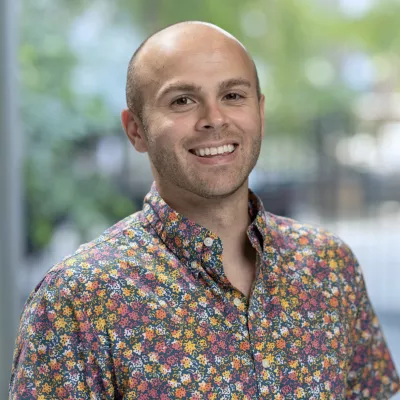Investigators urge careful monitoring for HHV-6 and iciHHV-6.

First author Caleb Lareau, PhD, Memorial Sloan Kettering Cancer Center
A recent publication in Nature (Lareau 2023) suggests that one source of the HHV-6B that reactivates in CAR-T cell therapy may be the CAR-T cells, themselves. The process of engineering and culturing the cells ex vivo before infusing them may encourage reactivation and viral replication. Thus, the CAR-T cells may sometimes be the “Trojan horse” within which the virus has entered the patient’s body.
A multi-institutional study led by investigators at Memorial Sloan Kettering and Stanford examined the creation of allogeneic and autologous CAR-T cell commercial products and discovered that a small group of cells become “super-expressors” of HHV-6B. The team documented that after infusion into patients, the virus reactivated, proliferated, and spread to other cells.
In an exploratory study, the investigators mined a petabase-scale resource, Serratus, that quantified viral abundance from RNA-sequencing (RNA-seq) and DNA-sequencing data from the Sequence Read Archive. The team looked for high-confidence viral RNA from 129 curated human viruses, focusing on the 17 viruses across the Herpesviridae, Polyomaviridae, Adenoviridae and Parvoviridae families. They identified positive samples for HHV-6B in primary CD4+ T cell cultures, including from patients in which no “record of the HHV-6 virus [had been] noted.”
Commercial CAR-T cell products: ex vivo studies. The team then monitored research-grade allogeneic CAR-T cells over a standard 19-day manufacturing time frame, and screened cultures with quantitative PCR (qPCR) to detect the U31 DNA from the HHV-6B virus.
Single cell sequencing revealed rare cells that were super-expressors of HHV-6B. The super-expressing cells were defined as cells with ≥ 10 viral transcripts, quanitfied by unique molecular identifiers (UMIs). Indeed, the team detected expression of 90 of 103 HHV-6B transcripts, including immediate-early viral genes that were enriched among a subset of super-expressors, suggesting that these cells had recently reactivated or been infected by HHV-6B. Such super-expressor cells constituted between 0.01% and 0.3% of all cells from three donors. Sequencing of the T cell receptor revealed that none of the HHV-6B+ cells from these donors shared a clonotype receptor sequence: the reactivation of HHV-6 may have begun in a single cell, but virus spread to other cells and/or reactivated from some of them, as well. Single cell sequencing also directly linked observed viral transcription to viral replication.
Cell cultures of the CAR-T cells then were extended beyond the typical 19-day manufacturing window—to 25-29 days. This led to a 12,00-2,000 fold increase in the abundance of HHV-6B transcripts: now, 49-62% of all T cells (not 0.01%-0.3%) were HHV-6 super-expressors, including both CD4+ and CD8+ cells.
The team noted some molecular correlates of super-expressor cells, as detailed in the report. The mere presence of the viral genome did not guarantee that a cell would become a super-expressor: for example, one donor had inherited chromosomally integrated HHV-6, yet the 19-day manufacturing period did not produce detectable viral RNA. Instead, the authors propose that HHV-6B reactivation is a stochastic event affected by various features of the cell culture and intrinsic differences in host cell state.
Commercial CAR-T cell products: in vivo studies. The team then screened single-cell expression profiles of 619,392 CAR T cells from pre-infusion products and 829,535 cells from peripheral blood draws several weeks post-infusion, all from autologous products. Single cell sequencing revealed a small number of engineered CAR-T cells expressing HHV-6B transcripts, including super-expressor cells. One of the two post-infusion patients with super-expressor cells was diagnosed with ICANS. Similar results were not found when PBMCs from >1 million cells from ~1,000 healthy blood donors were examined with the same techniques, indicating that HHV-6B is not detectable in peripheral blood with the same assay.
The team then thawed day-19 vials from allogeneic CAR T cell donors, treated them with or without foscarnet and extended the cultures for another 5 days. Using RT-qPCR, they demonstrated that the addition of foscarnet during culture led to a lower viral RNA abundance compared to the untreated controls. This experiment indicates that viral reactivation can be mitigated through the modification of ex vivo engineering processes.
Conclusions
- The creation, ex vivo, of CAR-T cell therapies can create some super-expressor cells that produce large amounts of HHV-6B; post-infusion, these cells express reactivated virus. The factors that affect these phenomena require study.
- It is likely that some cases of HHV-6 encephalitis, and possibly some cases of ICANS, that are seen in recipients of CAR-T cell therapy are due to this phenomenon.
- It is important to study whether some cases of pneumonia, cytokine release syndrome, and bone marrow depression post-CAR-T cell therapy might also be related to HHV-6B super-expressor CAR-T cells.
- It also is important to study whether identifying CAR-T cell products that contain super-expressor cells, and treating them with antivirals prior to infusion, might reduce the frequency of adverse clinical events after the CAR-T therapy.
- Given the potential benefits and rapid growth of CAR-T cell therapies, the studies summarized here indicate the need for more research on the role of HHV-6 reactivation in illnesses linked to CAR-T cell therapies.
- At the same time, we should not forget that exponentially more people currently receive “conventional” HCT than CAR-T cell therapy each year, that HHV-6-related diseases occur in HCT and that much more research is needed on how to prevent and treat these illnesses in recipients of HCT.
Part 2: CAR-T cell therapy and its complications
Part 3. HHV-6 Encephalitis in CAR-T Cell therapy
Read the full paper: Lareau 2023

